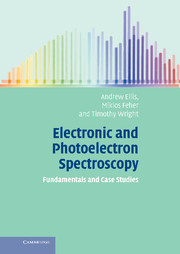Book contents
- Frontmatter
- Contents
- Preface
- List of journal abbreviations
- Part I Foundations of electronic and photoelectron spectroscopy
- Part II Experimental techniques
- Part III Case Studies
- Appendix A Units in spectroscopy
- Appendix B Electronic structure calculations
- Appendix C Coupling of angular momenta: electronic states
- Appendix D The principles of point group symmetry and group theory
- Appendix E More on electronic configurations and electronic states: degenerate orbitals and the Pauli principle
- Appendix F Nuclear spin statistics
- Appendix G Coupling of angular momenta: Hund's coupling cases
- Appendix H Computational simulation and analysis of rotational structure
- Index
Appendix E - More on electronic configurations and electronic states: degenerate orbitals and the Pauli principle
Published online by Cambridge University Press: 05 June 2012
- Frontmatter
- Contents
- Preface
- List of journal abbreviations
- Part I Foundations of electronic and photoelectron spectroscopy
- Part II Experimental techniques
- Part III Case Studies
- Appendix A Units in spectroscopy
- Appendix B Electronic structure calculations
- Appendix C Coupling of angular momenta: electronic states
- Appendix D The principles of point group symmetry and group theory
- Appendix E More on electronic configurations and electronic states: degenerate orbitals and the Pauli principle
- Appendix F Nuclear spin statistics
- Appendix G Coupling of angular momenta: Hund's coupling cases
- Appendix H Computational simulation and analysis of rotational structure
- Index
Summary
The Pauli exclusion principle states that no two electrons in an atom or molecule can share entirely the same set of quantum numbers. This requirement follows from the nature of electronic wavefunctions, which must be antisymmetric with respect to the exchange of any identical electrons. This has an impact in the determination of the electronic states possible from a given electronic configuration.
Atoms
Consider, for example, the carbon atom, which has a ground electronic configuration 1s22s22p2. Suppose that one of the 2p electrons is excited to a 3p orbital. To determine the electronic states that are possible from this configuration, the process described in Section 4.1 can be followed. The 1s and 2s orbitals are full and so we can focus on the p electrons only. The possible values of the total orbital angular momentum quantum number L are 2, 1 or 0. Similarly, the total spin quantum number must be 1 or 0 and so the possible electronic states that result from the 1s22s22p13p1 configuration are 3D, 1D, 3P, 1P, 3S, and 1S. It is therefore initially tempting to propose that electronic states of the same spatial and spin symmetry arise from the ground electronic configuration. Such an assumption would be wrong because it ignores the Pauli principle.
- Type
- Chapter
- Information
- Electronic and Photoelectron SpectroscopyFundamentals and Case Studies, pp. 266 - 268Publisher: Cambridge University PressPrint publication year: 2005



